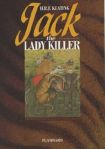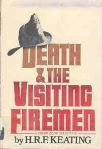|

|
Jack the Lady Killer (1999)
The Punjab in India. 1935. The sub-continent under the Raj. Fresh from his English boarding school, Jack Steele is a new recruit to the Indian Imperial Police and soon begins to acquire the attitudes of old India hands towards the people under their rule. Only a few months into his posting, Jack has to conduct a murder investigation when one of the British community at his Station, the sexually rapacious widow Milly Marchbanks, is found strangled. To Jack’s consternation, the only clue implicates a member of the club for the British. But which one? While Jack goes round and round in circles, his self-effacing Indian sergeant, Bulaki Ram, discreetly nudges him along the way he needs to go.
H. R. F. Keating is best known for his long series of Inspector Ghote mysteries set in India, but Jack, the Lady Killer is something completely different as well as completely unexpected. It is one of the rarest forms known to literature, a detective novel in verse. Inspired by Vikram Seth’s brilliantly successful revival of the verse novel in The Golden Gate, Keating develops his rhyme-crime in nearly 300 fourteen-line stanzas. During a writing career spanning forty years, Keating has won many honours, most notably the award of the CWA Cartier Diamond Dagger in 1996 for a lifetime’s achievement. Since 1985 he has been President of the Detection Club in succession to some of the greats of British crime fiction, G. K. Chesterton, Dorothy L. Sayers, Agatha Christie and Julian Symons. |
|

|
The Bad Detective (1999)
For years Detective Sergeant Jack Stallworthy has taken advantage of the extra perks available to him. He’s put away the criminals, made the town safer. Why shouldn’t he accept the bonuses for his hard work?. His beloved and beautiful wife, Lily, dreams of retiring on Ko Samul, an island paradise, while Jack would be content to retire to a modest bungalow in Devon. That is, until Jack meets influential businessman Emslie Warnaby. Emslie offers Jack a deal he can hardly refuse: In exchange for just one file at police headquarters, Jack will get the deeds of ownership to the first-class Calm Seas Hotel in Ko Samul. But the incriminating file turns out to be very hard indeed to get, and as Jack tries to complete the transaction, Lily grows impatient about her dream, Jack falls deeper and deeper into crime, and soon there’s no turning back.
|
|

|
The Soft Detective (1997)
DCI Phil Benholme has the reputation for being a little soft – but only because he tries to see both sides of every story. And now he is faced with the murder of Professor Unwala, winner of the Nobel Prize in 1945. What does a “soft cop” do when his teenage son is also his prime suspect?
|
|

|
The Good Detective (1995)
The author of ‘The Rich Detective’ continues to examine problems facing detectives, in this case how to combine his essential goodness of character with the demands made on him to get a result.
|
|

|
The Rich Detective (1993)
Riches beyond the dreams of avarice are the last thing on Bill Sylvester’s mind when he returns to England after a holiday in Spain. A detective inspector in South Mercia, Sylvester is greeted by an urgent summons from the chief constable himself. Meanwhile, the lottery ticket he bought so casually while on vacation lies forgotten in his wallet. Sylvester is asked to tackle a highly delicate case. An anonymous letter – alleging murder – received by the chief identifies a wealthy antiques dealer as the perpetrator of a ruthless scam against defenseless old ladies. Sylvester is soon on his way to the opulent home of Charles Roanoke – and what he witnesses there convinces him that the allegations against the dealer should be taken seriously. Before long Sylvester finds he is alone in believing in Roanoke’s guilt. Then he learns that his lottery ticket has won him almost a million pounds. Suddenly master of his own destiny, he resigns from the force. But Sylvester has become obsessed with pursuing Roanoke to the bitter end. An end that proves far more bitter than he at first realizes. For justice can sometimes exact a terrible price, even from a newly minted millionaire…
|
|
Into the Valley of Death (1986)
Written as Evelyn Hervey.
Temporarily released from her duties as a governess Harriet Unwin sets out to help her old friend Vilkins who is trying to prove that her employer’s husband is not guilty of the murder he is accused of
committing and she has to do it with expedition because he is due to be hanged. The area she travels to has been christened The Valley of Death but it turns out that this present murder has connections with the Crimean War and the book is punctuated with the resounding words of Tennyson’s poem. The race against time with a man’s life at stake is nail-bitingly agonising. |
|

|
The Man of Gold (1985)
Written as Evelyn Hervey.
Harriet Unwin seems destined to find herself employed in households where there is a murder. This time her heart becomes involved – something she has hitherto resisted – her endeavours to clear the man to whom she is attracted of a murder charge are not helped by the conventions of the times. But this is not a glossy romance it is a picture of life upstairs with all its snobberies and artificialities as well as depicting the drudgery and dreariness to say nothing of the degradation faced by those who live below stairs. Harriet from the regions mid-way between the two has to sort out not only the crime but also her own personal dilemmas. |
|

|
The Governess (1983)
Written as Evelyn Hervey.
This first of a Victorian trilogy originally written under the pseudonym of Evelyn Hervey but quickly recognised as being written by the sure hand of HRF Keating, it introduces Harriet Unwin who has risen from the lowliest workhouse childhood through ‘downstairs’ jobs to becoming a lady’s maid and upwards to the point where we meet her as a governess, a position that sits uneasily between the servants hall and the gentry upstairs. She soon finds her hard-won status in jeopardy when she is accused of murder. Extricating herself proves hazardous and complicated. But her task is made easier with the involvement of a figure from her workhouse past, the effervescent and delightful Vilkins who nevertheless remains firmly at the bottom of the household heap as a scullery maid. |
|

|
A Remarkable Case of Burglary (1975)
Val Leary is handsome, charming and broke. On the morning of April Fool’s Day 1871, while walking through one of London’s wealthiest districts, he notices a young maidservant scrubbing the steps of 53 Northbourne Park Villas. In that instant he conceives the idea for a remarkable case of burglary. The set-up seems perfect, but chance intervenes in a succession of coincidences that place the jewels further and further beyond the reach of Val and his cronies – until… |
|

|
Is Skin-Deep, Is Fatal (1965)
The book which precedes this, ‘The Perfect Murder’ brought inspector Ghote to life, making India predominant in place of finding a zany setting for each new book. But before that was so successfully published this story with its bizarre background had been written. The crimes takes place in the often vicious world of the beauty contest. Reviewers wanted the investigating officer, Superintendent Ironside, to become a series detective but with the creation of Ghote he never stood a chance so he remains an endearing one-off.
|
|

|
Death of a Fat God (1963)
Here the heightened world of opera seen during a season at a provincial opera house provides a light-hearted exploration of larger-than-life, many of them self-obsessed, characters There is an international cast of singers who take every opportunity of indulging their artistic temperaments, driving the volatile Spanish director to distraction and hindering the investigation into the inevitable murder. This book introduces the four-square charlady, Mrs Craggs, who, together with her lugubrious, self-delusional friend Mrs Milhorne remain one step ahead in solving the crime. Mrs Craggs is later featured in many short stories some of which are collected together in ‘Mrs Craggs, Crimes Cleared up.’ |
|

|
The Dog It Was That Died (1962)
Set in Ireland in and around Trinity College Dublin (where Keating spent four years as a student) there is indeed a delightful dog who suffers the same fate as the dog in the Oliver Goldsmith poem but the hero is likely to suffer a fate worse than death if he is caught by the gross villain whose specialism is brain-washing. This is a character based novel with a page-turning narrative. |
|

|
A Rush On the Ultimate (1961)
A residential gathering during the holidays at a minor public school where all the guests are croquet enthusiasts – the pursuit of gentlefolk who in this instance play a vicious game and turn out to have murky secrets in their past. After a murder occurs there is a race against time to prevent more crimes being committed. |
|

|
Zen There Was Murder (1960)
The first of the books with an underlying serious purpose – how truth can be manipulated to obscure facts – but this is hidden under the telling of a fast-moving plot set in the world of a week-end course on Zen Budhism. The course is run by a Zen expert who runs rings round the investigating officer aided and abetted by a richly varied group of students and two charming German au pairs whose chats together and act as a commentary on the escalating murder scene.
|
|

|
Death and the Visiting Firemen (1959)
Eccentric both in its setting – an English journey by coach-and four by a group of ‘Firemen’ from American on the way to their Annual Conference to be held in London – and also in the style of writing. On publication this style inspired both admiration and fury in almost equal measure but assured an explosive entry for Keating into the world of crime fiction. |